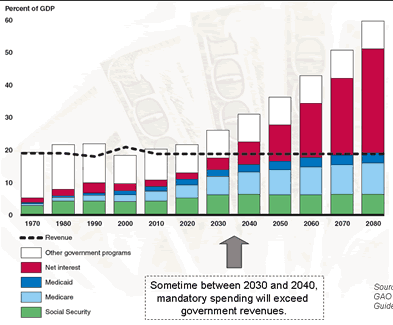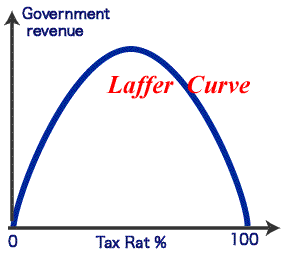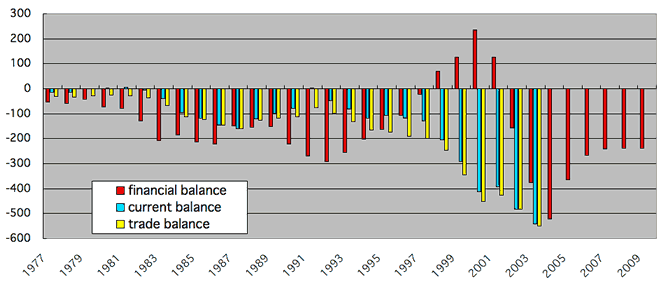 |
Fall of Dollar Castle |
Categrory: ECO |
|---|---|---|
Mitsuru Saito (斉藤満) |
up 09208 |
Title
Fall
of Dollar Castle
ドル落城
Index
Why?
-
This book was written in May 2003 just after the lost decade
of Japanese economics and 9.11 incident.
-
But this book predicts the fall of dollar castle;
its sign surely occurred in Sept 2008 again as financial crisis
in NYC.
- 本書は2003年5月に、日本経済の失われた10年と9.11事件以降に書かれた。
- しかし、本書はドルの落城を予測している。そしてその兆候は、2008年9月にまたNYで起きた。
Résumé
要約
>Top 1. The fall of US superpower:
- Bush doctrine:
- "preemptive strikes against potential enemies and promoting
democratic regime change. (2002)"
- declaration of uni-polar domination
- changed from Truman doctrine in 1947.
- Oil and US Dollar standard system:
- control of oil dollar as well as oil reserves of Venezuela
and Iraq. (Neo-conservatism)
- Axis of evil:
- Iraq, Iran, North Korea described by George W. Bush
- Cuba, Libya, Syria described by John R. Bolton
- Asian currency crisis in 1997:
- slash-and-burn financing in Asia
- Resistance of France, Russia & China:
- scramble for a share of Iraq oil
- disempowerment of UN
- John Stuart Mill, 1848:
- "Zero growth of capital and population do not means
stagnancy of human progress."
- Triangle relations:
- Anglo-Saxon vs. Islam vs. Jewish
- Ivy league
- Jewish hedge fund: LTCM
- Christian rightists vs. Neo-conservative vs. Jewish-rightists
- Greater Israel including Tigris and Euphrates
- War footing financial policy
- Increase of issue limit of government bond (2002/6):
- fight against terrorism: war between macro and micro
- Oil money:
- in the form of US Treasury Bill and US stock
- Unmonitored power will become corrupt.
- Crony capitalism:
- scandals of Enron and WorldCom
- Halliburton; Energy service and catering for military
- Allan Greenspan: (FRB chairman: 1987/8 -2006/1)
- "irrational
exuberance" (1996/12)
- PER (Price-earnings ratio) : around 10 times (1970s & 80s)
to more than 40 (1998-2001)
- IAS (International Accounting Standards) from GAAP (Generally
Accepted Accounting Principle) :
- Interminable war in Iraq:
- War is a kind of Keynes effect: inflationary effect
- Every war has not always positive effect.
- war without war-end anniversary
- cost of garrison bases
- Tense relations with Saudi Arabia
- 9.11 attackers are mostly Saudi (15/19)
- Refusal of use of Saudi bases to attack Afghanistan
- US expansionism:
- exploring the West
- immigrant influx:
- 4.5M/1970s
- 7.3M/1980s
- 9.1M/1990s
- housing demand of the immigrants
- Fire in the backyard:
- financial crisis in Latin America
- collapse of crawling peg system (2002):
- Venezuela
- Argentine (2002): from 1 peso to 4 pesos per US$1.
- cool-headed response of IMF
- Brazil (1999)
- Uruguay
- Mexico, eventually
1.
米国第一主義の破綻:
- ブッシュ・ドクトリン:
- 「潜在敵国および民主主義体制の変革に対し、先制攻撃を行う (2002)」
- 石油&ドル本位制
- 世界の石油マネーと石油資源の支配
- 悪の枢軸:
- イラク、イラン、北朝鮮
- キューバ、リビア、シリア
- アジア通貨危機 (1997):
- アジアでの焼き畑農業的金融
- 仏露中の抵抗
- イラク石油利権争奪
- 国連の無力化
- ジョン・ステュアート・ミル(1848)
- 「資本と人口のゼロ成長は、人間的進歩の停滞を意味しない。」
- 三角関係:
- アングロサクソン対イスラム対ユダヤ
- キリスト教右派、ネオコン、ユダヤ教右派
- 大イスラエル主義
- 国債発行上限の増加:2002/6
- 監視されない権力は腐敗する:Ronald Dore
- クローニー資本主義
- エンロン、ワールドコム事件
- ハリバートン:
- グリーンスパン(在任1987/8 - 2006/1):根拠なき熱狂
- 株価収益率(PER):70-80年代は約10倍だったが、1998-2001年には約40倍以上
- 国際会計基準(IAS)の採用
- イラクでの終わりなき戦い
- 戦争は一種のケインズ効果:インフレ効果
- 戦争はいつもはポジティブ効果をもたらさない。
- 終戦記念日なき戦争
- 駐屯基地の費用
- サウジアラビアとの緊張
- 9.11実行者15/19
- アフガニスタン攻撃にサウジ基地使用拒否
- 米国の拡張主]義
- 西部開拓
- 移民流入
- 450万人/70年代
- 730万人/80年代
- 910万人/90年代
- 移民の住宅需要
- 米国の裏庭での火事:
- 中南米での金融危機
- クローリング・ペッグ・システムの崩壊
- ベネズエラ
- アルゼンチン (2002)
- IMFの冷静な対応
- ブラジル (1999)
- ウルグアイ
- いずれはメキシコ
>Top
2. Warning sign of
US economics:
- US Economics: "Something strange"
- propping-up of the economy:
- scaled-up of immigrants:
- causing housing-bubble (50-80%)
- research of avoidance of deflation
- difficult to predict deflation.
- financial policy will have no effect.
- Federal Fund Rate (FF rate): (Policy Rate=Japanese Call
Rate)
- sharp drop from 6% to 1.75%
- "Taylor rule":(1993)
- a guideline for interest rate manipulation, introduced by
John Taylor; based on followings:
- target short-term nominal interest rate (=policy rate)
=
- consumer price inflation
rate +
- 0.5* (GDP gap) +
- 0.5* (actual inflation level - targeted inflation level)
+
- potential growth rate
- The rule recommends a relatively high interest rate (tight)
when inflation is above its target.
- In case of Japan:
- consumer price inflation level: -1%
- targeted inflation level: 1%
- GDP gap: -4%
- potential growth rate: 2.5%
- Therefore, Japanese policy rate should be:
-1 +0.5*(-4)+0.5*(-1-1) + 2.5 = -1.5
- in case of US:
- consumer price inflation level: 2%
- targeted inflation level 2%
- GDP gap: -2%
- potential growth rate: 3%
- US policy rate should be:
2+0.5*(-2)+0.5*(2-2)+3 = 4%
- Actual policy rate is too easy.
2. 米国経済に灯る危険信号:
- 米国経済:何か変だぞ
- 経済の下支えは
- 大規模移民
- 住宅バブル (50-80%価格上昇)
- デフレ回避の研究
- デフレ予測は困難
- 金融政策は無効
- FFレート (コールレート):
- 6%から1.75%へ急落
- テイラー・ルール (1993):
- 政策金利 =
- 消費者物価上昇率+
- 0.5*(GDPギャップ) +
- 0.5* (実際のインフレ率 - 目標インフレ率) +
- 潜在成長率
- 日本の場合:
- 上式での政策金利は-1.5%となる!
- 米国の場合:
- 上式での政策金利は4%となる。行き過ぎた緩和策
- >Top Debunking of Greenspan myth:
- Credit spread:
- difference of credibility causes that of interest
rate.
- difference in yield between T-bond and BBB corporate
bond
- normal: 1.4 - 1.7% spread
- coward: 2% spread
- Greenspan reduced FF rate at 1.25%, but the above spread
expanded 3.5%.
- Different pattern of recession which is different from hitherto
cyclical recession.
- Real interest rate could not be negative if inflation rate
become zero:
- Real interest rate = nominal interest rate - inflation rate
- For corporations and individuals, this inflation rate
is not actual consumer price inflation level, but 'expected
inflation rate.'
- In bubble era, the expected inflation rate seems higher;
thus real interest rate seems lower.
- But lackluster era, the real interest rate seems still higher.
- Automatic expansion momentum of economics does not function.
- In Japan, ease money policy will not function.
- Shadow of bubble economy:
- excessive debts behind growth without inflation
- the real cause is lurking in the prosperous 1990s.
- Coprorations made active capital investment, buth their inernal
reserve was not sufficient.
- Personal saving ratio is almost zero; they spent too
much using capital gain by stock and real estate.
- Corporate plant funds were supplied by government and
overseas.
- Usually inflation fear caused raise of market interest rate,
cooling down investment and consumpiton.
- But in 1990s overseas lower cost of money influxed.
- IT investment 13% of GDP.
- ROI decreased (particularly telecom industry).
- excessive equipment & plant, and excessive debts
- Debts balance: from 80% of GDP (1990s) to 90% (2001)
- グリーンスパン神話の崩壊:
- 信用格差:
- 信用力の差が金利差を生む
- 国債とBBB格付社債との金利差
- これが1.4-1.7%なら正常
- 2%なら憶病
- コールレートを1.25%に引き下げたが、上記格差は3.5%に拡大
- 従来の循環的景気後退とは異なることが起こっている。
- インフレ率がゼロになると、名目金利を下げても、実質金利はマイナスにならない。
- 実質金利=名目金利 - インフレ率
- 企業や個人にとって、このインフレ率は実際の消費者物価上昇率ではなく、「期待インフレ率」である。
- バブル期には、期待インフレ率が大きいので、実質金利は低く感じる。
- 自動的な経済拡大モメンタムが機能しない。
- バブル経済の影:
- インフレなき成長の影での過剰債務
- 繁栄の90年代に潜む真の原因
- 企業は積極的な設備投資を実施。但し内部留保は不十分
- 個人貯蓄率ほぼゼロ。株や不動産のキャピタルゲインを使って大量消費
- 企業の設備投資も政府および海外から資金供給
- 通常ならインフレ懸念が市場金利を高騰させ、投資や消費を抑制する。
- 1990年代は海外から安い資金コストで資金流入
- IT投資はGDPの13%
- ROI減少
(特に通信業)
- 過剰設備と過剰負債
- 債務残高;GDPの80%
- (90年年代)→90% (2001)
- >Top
- Bad loan of US corporations:
- US Telecom industry:
- $500B (=5% of US GDP $10T)
- half of the increased debt (1998-2001)
- Cf: Japansese bad loan: about $400B
- Credit Derivatives:
- Credit Default Swap (CDS)
- Resale of bad loan causes further decline of investment
will.
- Twin deficits in budget and trade.
- Budget surplus until 2001, but minus $150B in 2002 (1.5%
of GDP), $375B in 2003, $521B in 2004,
- Current account balance is more serious; minus $481B in
2002 (5% of GDP)
- US National Debt Clock: $10.7T (as of Feb7, 2009)
- Each citizen's share: $35K (US poputaltion 305M)
- Stronger or weaker dollar:
- US needs to procure money from abroad $2B everyday (250 days
a year)
- Most of recent foreging capital inflowed into stock market.
- 1990s: 3-5 times influx of current deficit.
- after 1998: 2 times influx of current deficit.
- after 2001: almost same level of corrent deficit. ('capital
flight")
- Fund-raising triangle players: US - Russia - Saudi Arabia
- Weaker dollar spiral:
- Quantitative easing policy -> decline of dollar interest
-> less influx of foregin fund
- 米国企業の不良債権:
- 通信産業:
- $500B (GDPの5%)
- 1998-2001までの不良債権の半分
- 日本の不良債権:約$400B
- クレジット・デリバティブ
- クレジット・デフォルト・スワップ
- 不良債権の転売はさらなる投資意欲減をもたらす。
- 財政と貿易の双子の赤字: (下表)
- 強いドルと弱いドル
- 米国は毎日$2Bの資金調達が必要。
- 資金調達の三者関係
- 弱いドルのスパイラル
- >Top Federal Funds (FF) rate:

- FF rate reduction could not be used as a weapon. ('Zero
interest rate syndrome')
- To continue easing policy, FRB needs to buy stocks from
market.
- US Treasury Bonds:
- US government urges Japanese government not to sell T-bonds,
rather to pour public money into banks or nationalize them.
- from shining decade (1990s) to sinking decade (2000-2010)
of US economy
 Rigidification
of US budget:
Rigidification
of US budget:
Sometime between 2030-2040, mandatory spending will exceed
government revenues.
- Social security (green)
- Medicare (light blue)
- Medicaid (dark blue)
- Net interest (red)
- Other government programs (white)
- Source: GAO, 2007
- Laffer Curve:
(1990s)
- Increase of tax rate do not necessarily mean increase tax revenue.
- 米国FFレート推移 (左図):
- ゼロ金利症候群
- もはや金融緩和策手詰まり
- 米国債:
- 日本政府に対し、米国債売りをしないよう圧力。
- むしろ税金注入、国有化
- 輝ける十年(90年代)から沈みゆく十年(2000-2010)
- 米国予算の硬直化 (左図):
- 2030-40頃、必須予算が全収入を超える。


>Top 3. Good deflation
and bad one:
- Containing policy of Japanese banks:
- US bonds and stocks as hostages
- Japanese personal assets: $14T
- Koizumi reforms backed by G.W.Bush administration
- Double standard of credit-rating firms:
- Moody's Investors Service:
- Yen-denominated government bond: A2
- Dollar-denominated assets: Aa1
- Current Japanese economic crisis is caused by political mismanagement.
- Incorrect diagnosis of Japanese economy
- Shouldn't: raise consumer price 1%.
- Should: overcome assets deflation
- Japanese land cost: $24T (1990) -> $14T (2002):
- this mean excessive debt is $10T
- loss of about 2
years of Japanese GDP
- Excess savings both in households and corporations:
- 10% of GDP = $500B every year
- totally $4T out of $10T was depreciated
- BS of Japanese economy:
-
Assets
Liability & Equity
Land value
-$10T
Debt compression
-$4T
Stock price
-$6T
- Contraction spiral of economy:
- Corporations repaid debts, not
spending investment or production.
- Thus caused decreasing demand and recession.
- furthermore, deteriorating individual income and stable employment
- Private sector's excess savings: $500B
- Japanese current account surplus: $100-150B
- Japanese government budged deficit: $400-350B
- total decade deficit accumulated $4T (=80% of GDP)
3. 良いデフレと悪いデフレの見極め:
- 日本の銀行封じ込め政策
- 人質としての米国債と株
- 日本の個人資産$14T
- 小泉改革はブッシュ支援
- 格付け会社の二重基準:
- 円建国債評価:A2
- 外貨建資産:Aa1
- 現在の日本経済の危機は政策運営のミスによる
- 日本経済の誤診
- 消費者物価1%上げは間違い
- 過剰資産デフレ克服やるべし
- 日本のバランスシート:
- 土地の資産価値減少:$10T
- 負債の圧縮:$4T
- 資本金(=株価)下落:$6T
- 経済の縮小スパイラル
- 会社は借入返済し、投資や生産に振り向けず
- 需要減退、不況へ
- さらに個人所得や安定雇用を揺るがす
- >Top High-yen phobia:
- excessive monetary easing policy: excessive liquidity
- fearing to lose competitiveness of export.
- Trauma since Nixon shock:
- 1971: Nixon shock and Smithsonian
agreement:
- ¥360 ->
¥308=US$1
- 1976-78: ¥180=US$1
- real growth in strong yen ages: 5.9%/1978, 5.4%/1979
- Japan is an anomalistic country to hate appreciation of own
currency.
- There has been no case of slumping into recession due to appreciating
yen.
- Income elasticity of export: about 2 (actually 1.8 - 2)
- if overseas demand
increased 5%. Japanese export will increase 10%
- while, 'price elasticity of export is 0.5 (actually 0.2)
- if export
price increased 1%, the export volume decreases 0.5%.
- Reasons:
- less number of competitors
- offshore plants depend on Japanese parts.
- Even, high yen (¥80=US$1) in 1995 did not drop Japanese export.
- 円高恐怖症:
- 行き過ぎた金融緩和 (過剰流動性)
- 輸出競争力低下を嫌う
- ニクソンショックのトラウマ
- 円高の1978-79年は高成長維持
- 日本は、自国通貨が強くなることを嫌う希有な国
- 円高で景気が腰折れしたケースはない。
- 輸出の所得弾性値:2
- 輸出の価格弾性値:0.5
- 理由:
少ない競争相手
海外工場も日本製部品に依存
- 1995年の円高でも日本の輸出減少せず
- >Top Merit of high-yen:
- boost domestic consumption
- maintain price stability, promoting domestic income or
buying motivation of financial asset.
- Stock-centric economy is important:
- James Tobin (1918-2002)
- gross national wealth attains 20%
of GDP
- Improvement of trade terms:
- decrease of import price is bigger than that of export
price.
- decrease of purchase price becomes more than that
of sales price.
- Pattern of decreased sales and increased profit
- high yen age (1978)
- Misunderstanding in high-yen trend:
- 80% cases since the floating rate system:
- Downturn in economy: high-yen
- Upswing in economy: low-yen
- Actual exchange rate in economic boom: from ¥120 (1988) to
¥160 (1990)
- Exchange rate in slump: from ¥160 (sprint 1990) to ¥95
(spring 1995)
- Low-yen in boom:
- increase of import -> increase of corporate profit ->
more overseas investment -> more purchase of dollar ->
high-dollar & low-yen
- High-yen in slump:
- decrease of import -> decrease of corporate profit -> less
overseas investment -> less purchase of dollar -> low-dollar
& high yen
- Bond and trade market tends to reverse with stock market.
- rise of stock market -> rise of long-term interest rate
-> downtrend of bond price
- 円高の効用:
- 内需増加
- 価格の安定、国内収入や金融資産購入のインセンティブ
- ストック重視の経済
- James Tobin
- 国民総資産はGDPの20%
- 交易条件の改善
- 輸入価格の下落は輸出価格の下落より大きい=交易条件
- 減収増益のパターン
- 円高傾向に対する誤解
- 変動相場制以来、8割は
- 景気後退時に円高
- 景気上昇時に円安
- 好況時:
¥120->¥160
- 不況時:
¥160->¥95
- 好況時の円安の理由は
- 輸入増
->企業利益増
->海外投資増
->円需要増
->ドル高円安
- 債権・貿易市場は株式市場とは逆行傾向
- 株高
->長期金利上昇
->債権価格下落
- >Top Misstep of measures against deflation:
- too much measures against goods and services deflation rather
than asset deflation.
- deflation -> downtrend of sales -> burden of debt -> burden
of excessive debt organizations (corporation & government)
- deflation means shift of buying power from corporations/government
to individuals.
- Causes of deflation
- Cf: Inflation
- cost push inflation (such as import inflation9
- demand pull inflation (too much demand)
- increase of productivity gap inflation (pricing based on
lower productivity)
- Cost down deflation:
- by technical innovation (use of e-Commerce)
- increase of import from
China
- Demand shrink deflation:
- rapid down of GDP
- Marshall-K: ratio of money supply to economic
activity
- デフレ対策の失政
- 資産デフレ対策ではなく、商品サービスデフレ対策過剰
- デフレ
->売上減
->負債負担増
->過剰負債組織の負担 (会社・政府)
- デフレは、購買力を会社・政府から個人に移転させる
- デフレの原因
- Cf: インフレの原因
- コスト・プッシュインフレ (輸入インフレなど)
- デマンド・プル・インフレ (需要激増)
- 生産性上昇格差インフレ (生産性の低い所に合わせた価格設定)
- コスト・ダウン・デフレ:
- 技術革新
- 中国からの輸入増
- デマンド減デフレ
- スクラップ下落
- 現実のGDP急激な落ち込み
- >Top Consumer's price in Japan:
- comparative high price due to various regulations.
- ppp is around ¥110
- big wholesale market:
- US: 1.6 times of retail market
- Japan: 4 times of retail market (showing downward trend:
distribution revolution)
- After effect of asset deflation:
- Three excess:
- excessive facility, excessive debt, excessive labor.
- Inflation target:
- "Is deflation a monetary phenomenon?"
- GDP $5T or Total asset $90T
- Japan poured currency since 1995, but consumer price shows
falling trend contrary to the quantity theory of money.
- Balance of current account of private banks in BOJ: now $200B
- But $60B is enough to release the clutch.
- Japanese economy after collapse of bubble shows diabetic symptoms:
excessive facility, excessive debt.
- Why doesn't increase money supply in Japan?
- BOJ pours money in current account of private banks ($0.2T)
- Total currency in circulation: $7T
- Credit creation vs. helicopter money
- credit multiplier was 10-15 times, but now is almost 8
times.
- amount of loans by private banks is essential.
- Bank account:
- amount of loan ($1M) to a corporation
-> increase of loan
asset of the corporation ($1M)
-> cash transfer to current account
of the corporation
-> when the corporation draws money from
account, then cash is delivered from BOJ.
- Why PT does not increase though M is poured?
- relative price vs. absolute price
- In Japan, V continues to drop.
- Policy of letting the yen fall; contradictory if government
believed 'absolute price.'
- Or quantitative easing policy has been urged by US?
- Adverse effect of inflation target policy:
- Inflation target policy
is effective in case of curbing inflation.
- Private banks presently owns $1T of national bond, while
total M2+CD is about $7T.
- If they want to sell national bond suddenly, it may cause
rapid rise of long-term interest (=sharp drop of bond market) .
- If this occurs at account end, it causes appraised loss
of securities own by private corporations.
- because $1T national bond holder is very sensitive to
inflation (=anticipation of rise).
- if 50% of national bond is sold ($0.5T), it may effect
shrinking money supply by 7% decrease.
- down of real wage and decrease of financial asset value ->
decline of living standard -> transfer to foreign consumer,
excessive debt corporations, and government.
- inflation target and low-yen will eventually cause increase
of tax.
- $14T financial asset holding individuals will shift their
buying power of $0.14T to corporations and government. (=equivalent
of 7% of consumption tax)
- If transfer of buying power is necessary, it is more
democratic to induce increase of consumption tax and decrease
of corporate tax.
- 日本の消費者物価:
- 諸規制のてめ消費者物価は高め
- PPPは¥110程度
- 巨大な卸売市場
- 米国は小売市場の1.6倍、日本は4倍
- 資産デフレの後遺症:
- 3つの過剰:設備、負債、雇用
- インフレ・ターゲット:
- デフレは通貨減少か?
- GDP 500兆円か総資産9000兆円か
- 1995年以来通貨の量的緩和策実施。しかし消費者物価は下降傾向。
- 日銀当座預金残高:20兆円
- バブル崩壊以降の日本経済は糖尿病の兆候:過剰設備・負債
- なぜ日本ではマネー・サプライが増加しないのか?
- 信用創造 vs.ヘリコプターマネー
- 信用乗数:従来は10-15倍、現在は約8倍
- 民間銀行による貸出額が本質
- 銀行会計:
- ある企業への貸出1億円
→その企業向け貸出資産1億円→その企業の当座へ振込
→企業が実際に現金引き出し→日銀から銀行経由で市中に現金流通
- なぜMが増加しても、PTは増えないのか
- 相対物価 vs.絶対物価
- インフレ・ターゲットの副作用:
- インフレ・ターゲットはインフレ抑制には有効
- 金融機関は国債100兆円保有 (M2+CD合計は約700兆円)
- もし、インフレの恐れがあると金融機関は国債の売却を行う可能性あり
->長期金利の急騰
-> 債券市場の急落
- もし50%の国債売却でも、通貨供給は7%となる。
- 購買力の移転が必要なら、消費税増税と法人税減税を世に問うべき。
- さらに実質賃金目減り、実質金融資産の目減り
->生活水準引き下げ
->その分海外の消費者、過剰債務企業、国に強制移転
- 消費者にとってはインフレ増税、円安増税に等しい
- 1400兆円の金融資産をもつ個人から1% = 14兆円移転すれば、消費税7%分に相当
- 購買力の移転が必要ならば、消費税増税、法人税減税を提案する方が民主的。
>Top Monetary exchange equation: Alfred Marshall (1842-1924)
- MV = PT
(Quantity theory of money by Irving Fisher)
- M is total dollars, V is the number of times per year
each dollar is spent, P is the average price of all goods & services,
T is the quantity of assets, goods & services sold.
- M is usually M2 + CD, ie, currency in circulation + checkable
deposits + savings deposits + certificate of deposit
- V=Velocity: number of times per year that money turns
over in transactions (Velocity of circulation of money)
- MV = PY
- M = k PY
- Y is real GDP, which replaced T
- k = 1/V; defined as M/PY, ie,
Money supply / nominal GDP; which is called Marshall's k .
(Alfred Marshall)
貨幣交換方程式 (フィッシャーの貨幣数量説)
- MV = PT
- 通貨量、通常はM2+CD
- T: 財の取引量
- V: 貨幣の取引流通速度
- MV = PY
- M = k PY
- Y: 実質GDP
- k = 1/V = M/PYを
(
マーシャルのK )
>Top 4.
Three mistakes dampening economic recovery:
- Financial policy is a brake function, not acceleration
- There are restrictive measures, but no effective stimulating
measures.
- But in economy, there is 'momentum,' which tends to advance
autonomously.
- Reverse of a vessel which has accelerator, but
no brake, and has no momentum to advance.
- Central bank is compared with a horseman, who reins properly
(=control of interest) or whip (= money supply),
unless
the horse
became exhausted; it cannot advance any more by whipping.
- Or it is compared with kite-flying: it can wound up string
as long as wind exists. (push on a string)
- Globalization of economy:
- Evaluation of quantitative easing policy:
- the original target is:
- to push down market money rate
- portfolio rebalance effect; to promote buy stocks, foreign
assets causing further low-yen.
- to make consumers or corporations to expect inflation.
- Market money rate:
- rather shows uptrend of long-term interest
- Portfolio rebalance:
- temporally stock market shows uptrend, but soon it declined.
- actually no effect on exchange market, tends to high-yen.
- Additional quantitative easing policies of BOJ:
- direct corporate finance
- ETF (Exchange Traded Fund)
- REIT (Real Estate Investment Trust)
- Beyond Keynesian-style policy:
- "Rational expectations theory"
- Government spending may cause soon tax raise.
- "Laffer curve"
- Tax rate reduction may cause increase of tax revenues.
- EU Maastricht conditions
- government debt should be less than 60% of GDP.
- Japan is now 130% of GDP.
- Balance Sheet recession:
- different from conventional cyclical recession.
- Collapse of bubble economy:
- decline in land prices: $10T
- loss of stock prices: $6T
- annual Japanese GDP ($0.8T) cannot compete with the
above two losses.
- Assets at market value:
- Corporations are directly affected by this in the process of
asset deflation.
- Cf: US apply fair value, not exact market value. Also has various
exceptions; not applicable to real estate investment affiliate.
- originally
applied in Germany in 1861 and abolished in 1984.
4.
景気回復を引っ張る三つの間違い:
- 金融政策はブレーキ機能であってアクセルはない。
- 引き締め策はとれるが刺激策はとれない。
- 但し、経済に推進力 (モメンタム)がある。放置すると推進する。
- 船にはアクセルはあるはブレーキもモメンタムもない。
- 中央銀行は騎手に例えられる。手綱さばき (=金利)や鞭 (マネーサプライ)で馬を制御する。
- また凧揚げに例えられる。糸は風があれば巻き上げ可能。
- 追加量的緩和政策:
- 直接の企業支援
- 上場株式投信 (ETF)
- 不動産投資信託 (REIT)
- 非ケインズ政策:
- 合理的期待形成論
財政支出増は、いずれ増税に
- ラッファー・カーブ:
税率下げても景気拡大で税収増に
- EU:政府債務はGDPの60%以内
- バランスシート不況:
- 従来の循環型不況とは異なる
- バブル経済崩壊後
- 土地下落;1000兆円
- 株価下落:600兆円
- 年GDP80兆円では太刀打ちできない。
- 資産の時価会計:
- 資産デフレの中で企業は直撃
- 米国は、公正な価格採用。また例外あり。
- 元来は独で1861年に採用。
>Top 5. Beginning of reversal
of US and Japanese economics:
- Fundamental power of Japanese economy:
basically stock-based economy (=asset-based) rather than flow-based
(=profit-loss based) economy.
- Natural healing ability of Japanese economy.
- halting deflation spiral.
- increase of stock: financial asset recovered to $14T (5 times
of annual consumption) from the heyday of bubble ($10T)
- individuals' balance of deposit: still remain at a high level.
- stable consumption
- gross national wealth: $40T (8 times of GDP)
- High-yen functions built-in stabilizer:
- domestic demand-led economy.
- Avoid political pressure from US:
- Deep-pocketed Japanese economy:
- balance of national bond: $4T vs. foreign investors fund $0.1T
- still sustainable government debt ($6.3T). The situation is
different from those of Argentine, Korea, or Italy.
- Foreign investors are essentially have-not's; they need to
make loan or borrow stocks from others (insurance company, etc.)
- But if haves (Japanese government and banks) sell T-bills which
will be one-way ticket; causing rise of long-term interest and
low-dollar.
- 'Capital flight' has limit: Japanese will sell dollars
asset some time.
- US will experience BS adjustment by asset deflation, which was
experienced by Japan in 1990s.
- Cost of war against terrorism:
- Economic and social disparity in US:
- 1% rich people owns half wealth of US.
- 50M immigrant during last 100 years (20% of US citizen).
- 40 times number of lawyers compared to that of Japan.
- Potential of Japanese economy which is sustainable under the
prolonged foolish policies.
5.
日米の逆転が始まる:
- 日本経済の底力:
基本的には資産重視のストック型経済(収支重視のフロー型経済ではない)
- 自然治癒力
- デフレスパイラル回避
- ストック増強:1400兆円 (年間消費の5倍)
- 個人貯蓄残高:高いレベルで推移
- 安定した消費
- 国民総資産:4000兆円 (GDPの8倍)
- 円高に内在する自律的安定機能 (ビルトイン・スタビライザー)
- 米国からの政治圧力の回避:
- 日本経済の懐の深さ:
- 国債残高 400兆円 vs. 外資ファンド10兆円
- 政府債務 630兆円はまだ支えられる。状況はアルゼンチン、韓国、イタリーとは異なる。
- 外資投資家は基本的には持たざる者である。彼らは借入金か借り株 (生保などから)のいずれか。
- しかし持つ者 (日本政府や銀行)が米国国債を売りに出せば片道切符となる。
- キャピタルフライトには限界がある。日本人はドル債権はいつかは売却する。
- 米国は、資産デフレによるBS調整を経験することになる。それは日本が90年代に体験した。
- 米国の経済的社会的格差:
- 1%の金持ちが国富の半分を所有
- 過去100年間に5000万人の移民
- 日本の40倍もの弁護士
- 長期間の無謀な政策に耐える日本経済ポテンシャル
Comment
- This book contains in-depth analysis of the lost decade, elongated
recession during 1990s. And still Japan has not yet recovered from
the trauma.
- Does it really occur again "The rise and fall of great powers" in 21st century"?
- 本書は1990年代の長引いた不況である失われた十年について深い分析をしている。そして日本はまだそのトラウマから回復していない。
- 21世紀には再び21世紀の「大国の興亡」が起こるのだろうか?
Title |
Fall of Dollar Castle |
ドル落城 |
|---|---|---|
Index |
||
Why? |
|
|
Résumé |
要約 |
||||||||||||
>Top 1. The fall of US superpower:
|
1. 米国第一主義の破綻:
|
||||||||||||
>Top 2. Warning sign of US economics:
|
2. 米国経済に灯る危険信号:
|
||||||||||||
|
|
||||||||||||
|
|
||||||||||||
|
|
||||||||||||
 |
|||||||||||||
>Top 3. Good deflation and bad one:
|
3. 良いデフレと悪いデフレの見極め:
|
||||||||||||
|
|
||||||||||||
|
|
||||||||||||
|
|
||||||||||||
|
|
||||||||||||
>Top Monetary exchange equation: Alfred Marshall (1842-1924)
|
貨幣交換方程式 (フィッシャーの貨幣数量説)
|
||||||||||||
>Top 4. Three mistakes dampening economic recovery:
|
4. 景気回復を引っ張る三つの間違い:
|
||||||||||||
>Top 5. Beginning of reversal of US and Japanese economics:
|
5. 日米の逆転が始まる:
|
||||||||||||
| Comment |
|
|